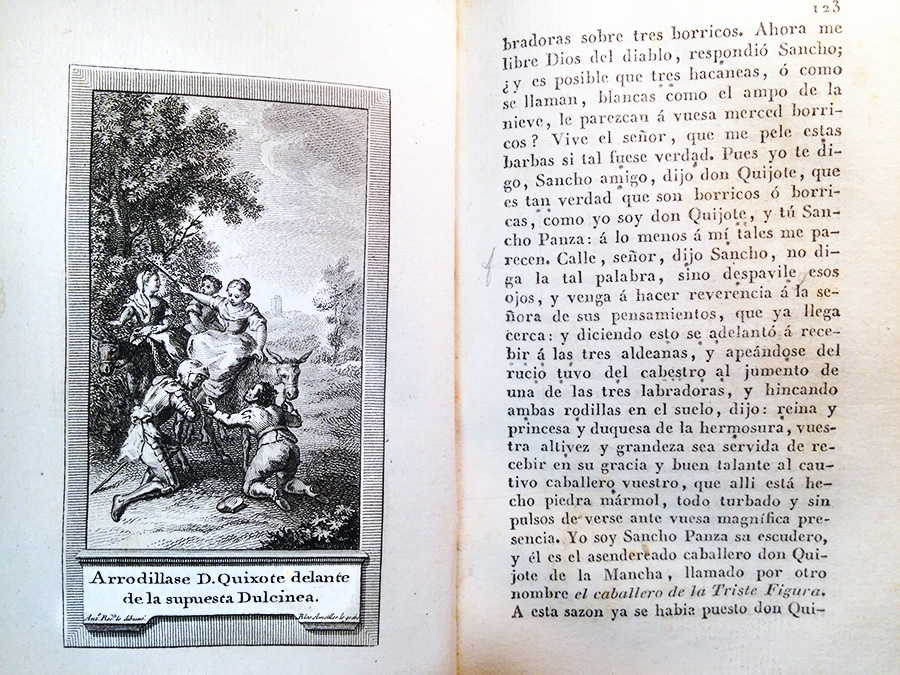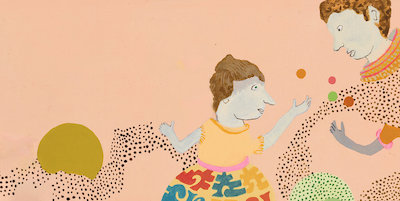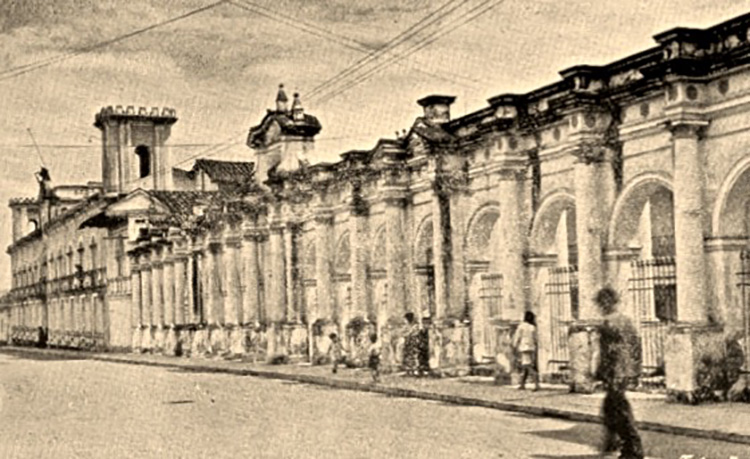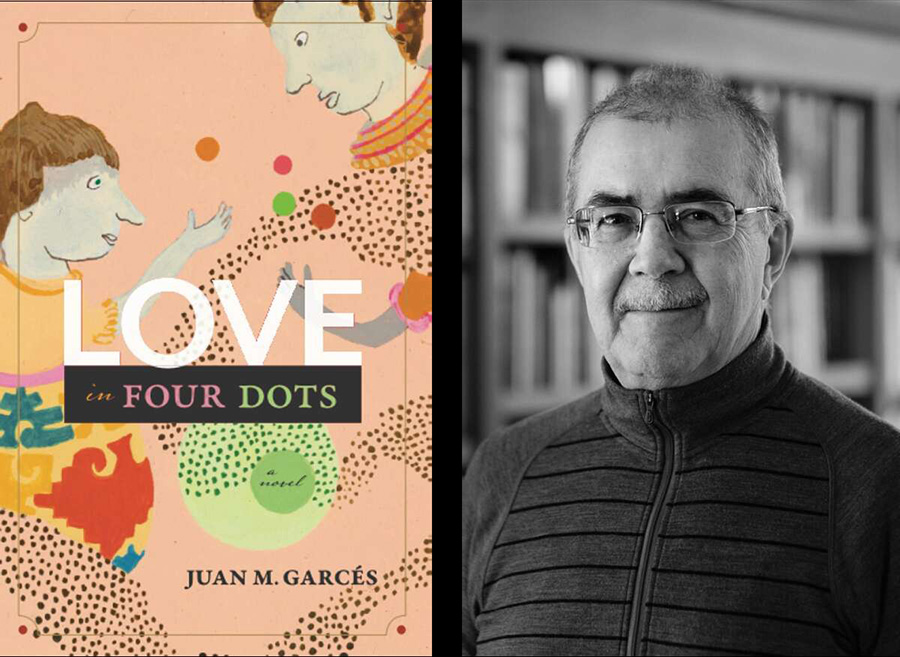
A copy of the 1844 volume of Don Quixote with an engraving of Dulcinea del Toboso, and the secret pencil dot code and initial “S” under the words “despavile esos” on page 132 made by Sofia Uzuriaga.
Author Juan M. Garcés (b. 1945) is a native of Cali, Colombia, a retired chemist, and a longterm resident of Midland, Michigan. He recently contacted us about a novel he wrote and self-published in his retirement, after a lifetime working in the field of chemistry. His book Love in Four Dots, was an idea that stayed close to Garcés since 1967, when he discovered letters between two lovers made in a secret pencil dot code inside a small stray volume of an 1844 edition of Don Quixote, a volume he purchased for its etchings on a whim from a used bookdealer in his hometown of Cali.
The book Don Quixote was smuggled into a military prison with the hidden letters written in code between Sofia and her lover Federico, a political prisoner during the One Thousand Days War (1899-1902). On his retirement, Garcés journeyed back to Colombia to research and help unravel the mysteries he found inside his copy of Don Quixote. The novel by Garcés weaves a labyrinth of threads between the lovers, the historical record of the civil war, the Cervantes’ masterwork, and how it leads back to the author and his own family history.
Juan M. Garcés will read from and present Love in Four Dots at Book Beat on Sunday, April 23, between 2-3 pm as part of our Sant Jordi Day celebration from 12-5 pm. Copies of his book in Spanish and English will be available: Please call (248) 968-1190 to reserve a copy. Books can also be preordered online at the Book Beat gallery and will ship after April 23.
An Interview with Juan M. Garcés
Love in Four Dots was a passion project. When you first discovered the lover’s code in your copy of Don Quixote, you mentioned how the idea of writing something about it sat buried inside you for years. How did you maintain your interest for the story and was the passage of time an advantage?
After I discovered the letters in the little book in the middle of June of 1967, I never forgot that I had a treasure in my hands. Also, I felt a responsibility to the authors of those letters who claimed their love was immortal. The only way to make it so was to let the world know about their lives. I felt I had been chosen to play that role at some time in my life, after I had analyzed the letters and their content within the historical moment. In 1967 I was just becoming an adult, about to finish his college training in chemistry and chemical engineering. I must add to that I also took numerous courses in the humanities to get a better-grounded education. From very early in life, I was already reading biographies of famous persons such as Napoleon, Gandhi, Jesus, Bolívar, Socrates, etc.
Another thing I did was read broadly on topics related to the historical moment of the letters such as The One Thousand Days war (1899-1902), the Panama Canal (1850’s to 1914) and talked to people that could appreciate the letters and their potential to write a story about them. I did that at the Universidad del Valle, my alma mater, and later at Ohio University where I did my Ph.D. studies in Physical Chemistry. In my own family I had my father who was a teacher and a brother who studied literature and law in college.
Yes, time was an advantage. As I grew up and learned about love and romance, got married, raised a family, and developed an outstanding career in chemistry with interactions all over the world, I became better informed about politics and the history of Colombia from its origins in the 1500’s until our days. My wife has a Master in Spanish literature, and we share our interest in Don Quixote. My own children expanded my horizons and made contributions to the creation of my novel in both languages.
Finally, after I retired, I had the time and the resources to work on the story. Also, I was a mature adult with a more complete vision of life and history capable of working in a serious way to write a novel about the letters and their authors.
With your background in chemistry and science, I’m wondering how you adapted to write a novel of historical fiction? It must have been exciting to be “unchained” and free to use your imagination after years of following scientific data. What did you find challenging in writing this first novel, and how did you manage the translation by yourself and your wife? Was the original version written in Spanish?
Yes, I became free, unchained for the first time in my life. I had been working since I was ten. My family was grown up and only one of my children was still at home. I selected historical fiction because the letters were closely tied to a special historical moment in Colombia, The One Thousand Days war. This violent war is still alive in the continuous guerrilla activity that has affected Colombia since the early 1900’s until our time. I selected fiction because I would never get to know all the details of the lives of the people involved in the story. I had to invent it. The letters were written in Spanish, my native language. However, I live in English and have a family that speaks English…and Spanish. The largest market for books is in English. Thus, a translation was needed. Moreover, both my wife and I were familiar enough with both languages to be ready to produce the English version. Later, I hired professional editors in English and Spanish to review our work and make a first-class product.
There is a real love for books and bookshops within your novel. You say in the novel that “ink smells like the spirit of ideas.” What other novels (beside Don Quixote) were inspiring for you? What books would you take to your “deserted island” to read?
My love for books goes to my early life. I built my own library and had a select collection of books at my bedside since early in high school. My father introduced me to secondhand bookstores and from the age of ten or so I was on my own, looking for special books. I still find bookstores at any place I visit. When I go into any home I look for the books. It’s hard to say what books I would take to my island. They continue to change as I grow in age and always include a variety of topics. I read politics, religion, literature, physics more than chemistry, the environment, the future, etc. I read many of the key authors from English, French, Spanish, Russian, German, Italian and Greek and Latin literature. In Spanish I was influenced by Ortega y Gasset, from Spain, as you can see in many of the quotes in my book. He was a philosopher and a journalist. My intellectual father.

The Military Jail that housed Fredrico in Papayán is now the Hotel Monasterio. “The meager diet converted the strongest into an invalid…”
A lot of research went into the Thousand Day War –and you’ve brought that time into rich detail. Many people may not be familiar with this period of Colombia’s history, except perhaps readers of One Hundred Years of Solitude. Why do you fell that time period and Columbia’s civil war and politics are still relevant?
The One Thousand Days war is to Colombia what the Civil War is to the USA. In some ways we are still fighting them. This makes them relevant in our own days because the stories of both countries are connected in many ways that are beyond the scope of this conversation.
One of my favorite things about Love in Four Dots is how the code of the letters follow and mirror letters inside of Don Quixote. This ingenious devise used by Sofia, was picked up in your plotting and becomes a mirroring theme in the book. By including your own research used by the narrator, that doubling effect also follows along with your introduction and afterword. Was that something you chose consciously—that helped map out the book, or did the development of characters and plot happen by intuition, by speaking to you as you wrote?
What makes the letters special is the use of two codes by the lovers to communicate. The dots and the dialogues of Sancho and Don Quixote. There is nothing like this. It’s unique. I didn’t realize in a deep way the importance of this aspect until I was well into the novel. It opened a whole universe to explore. It challenged me to develop a strategy to communicate this to the reader in a straightforward way. It was my most difficult part of writing the novel, well beyond than the plot and the characters.
Finding Victor was a lottery. Following the money came from my interest in politics. I felt by intuition it was the way to find them. But I got lucky having the help of a special librarian that happened to be my second cousin. She oriented me to the sources to find my characters. Yes, I was very happy with the connections I made at the time but later I realized I could have done a better job. I just had time limitations and needed to get back to write to finish the novel. I did my best to provide a fictional life to the couple. However, it is impossible to know if I did justice to their actual lives.
As you suspect, publication of the book brought more to light. The grandchildren of Sofia and Federico read it, invited by Victor who is their cousin, and found it fantastic. They knew more about some things, and I knew more in general. However, what I learned beyond their family names I did not include in the novel. Simply because it was already written, and I didn’t need to do that. I also didn’t want to hurt anyone including aspects of their lives that would be better left where they are.
I’m also curious how you found the cover painting for the book? Was it a commission? It’s very beautiful and matches the theme of codes and patterns found in the book.
The book cover comes from a painting made by my daughter in-law, it was selected by my youngest daughter who designed the whole book production. She had seen the painting and thought it would be a great cover. She proposed it to me and at first I didn’t agree because it included animals in the hands of the characters. My son, an artist and expert in computers and imaging removed the animals, added a few balls and presto, the cover was ready. An amazing job by all the players. All together it helps to have a very creative family.

